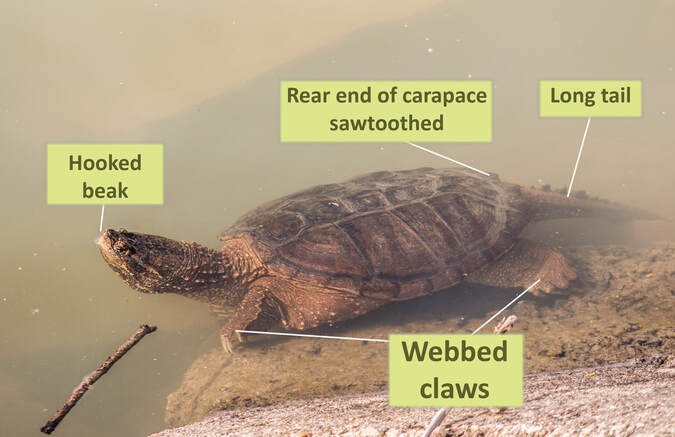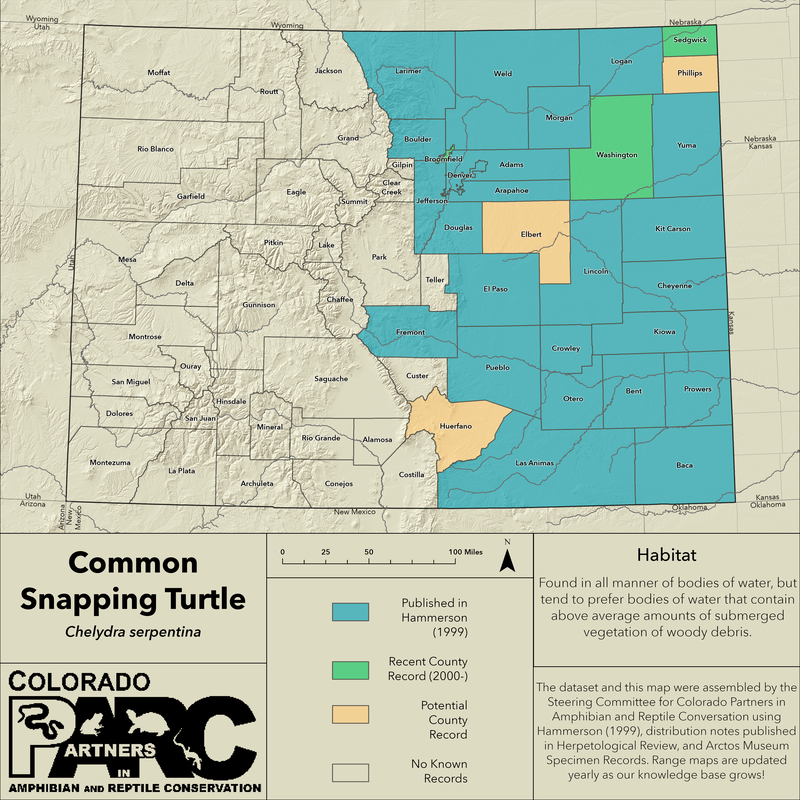|
Identification:
Distribution: Found throughout the eastern half of Colorado in elevations below 5,500ft (1,680m).
(Hammerson 1999) Activity: Snapping turtles can be active as early as March and typically become inactive to brumate in October. They spend the majority of their active time sitting or crawling along the bottom of bodies of water scavenging for food, but are most often observed when they are basking near or over bodies of water and when they are traversing on land between bodies of water. Males are more active in the months of March and April in search of females while females are more active in the months of May and June looking for nesting sites. (Hammerson 1999)
Conservation Status: Common snapping turtles are considered a species of least concern in the United states and in the state of Colorado they are a small game species. There are currently no signs of their decline in their Colorado range.
NatureServe rank: G5 (Globally Secure), S4 (State Apparently Secure). |
Habitat: Snapping turtles are found in all manner of bodies of water, but tend to prefer bodies of water that contain above average amounts of submerged vegetation of woody debris. (Hammerson 1999)
Diet: Snapping turtles are generalist omnivores that spend most of their feeding time under the water. They have been observed to prey upon fish, amphibians, birds, small mammals, invertebrates and have been observed to feed upon carcasses. Snapping turtles have also been observed to occasionally consume plant material. (Hammerson 1999)
Defense: Snapping turtles are equipped with a large and sharp beak, attached to a neck that has the ability to reach behind the turtle over it’s carapace. They are also known to take a defensive stance when approached and can lunge forwards to deter would-be predators. (Hammerson 1999)
Natural Predators: As adults they have very few predators outside of humans. As eggs and juveniles they are preyed upon by small mammals, bullfrogs, other turtles, fish, predatory birds and snakes. (Hammerson 1999)
|
Cited & Additional Resources
Hammerson G. A. 1999. Amphibians and Reptiles in Colorado. University Press Colorado, Boulder.
McGinnis, S. M., Stebbins, R. C. (2018). Peterson Field Guide to Western Reptiles and Amphibians. Houghton Mifflin Harcourt Company.
Hammerson G. A. 1999. Amphibians and Reptiles in Colorado. University Press Colorado, Boulder.
McGinnis, S. M., Stebbins, R. C. (2018). Peterson Field Guide to Western Reptiles and Amphibians. Houghton Mifflin Harcourt Company.
Account compiled by: Rémi Pattyn
Reviewed by:
Last Updated: 12/11/2022 by Anthony Berardi
Reviewed by:
Last Updated: 12/11/2022 by Anthony Berardi



